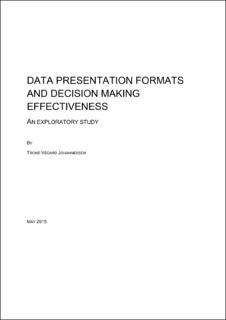Data presentation formats And decision making effectiveness
Doctoral thesis
Permanent lenke
https://hdl.handle.net/11250/2643354Utgivelsesdato
2015-06Metadata
Vis full innførselSamlinger
Sammendrag
The purpose of this thesis is to enhance the understanding of how data presentation formats
may affect managerial decision processes.
Compared to previous studies in this area, I have examined decision makers’ need for data
presentation formats in tasks that are more similar to real-life managerial tasks. I have focused
not only on the outcome of a decision process, but also on how presentation formats may support
decision makers’ mental representation of the task and their decision process. In addition to
studying the effects of either tables or graphs, I have included a combined presentation format.
Furthermore, I have allowed the subjects to use decision aids, such as MS Excel.
In two experimental studies, I have explored how MBA students used graphs, tables and both
presentation formats to solve two tasks varying in complexity and uncertainty. In Study 1, I
used verbal protocols to gain insights into how the subjects applied the presentation formats. In
Study 2, I also used eye tracking to complement the verbal-protocol data.
I found that decision makers need both presentation formats. Tables provide a basis for
calculations to facilitate the integration of decision variables and result variables, which is
important for effective decision making. Graphs provide an overview of the relationships
among variables. Particularly XY graphs were important to enhance the decision makers’
understanding of causal relationships among variables in the early phase of the decision process.
Line graphs were primarily used to check whether the development of the result was as
expected.
My findings have implications for designers of information systems. Designers should include
both tables and graphs in computerised systems to support managerial decision processes.
Furthermore, data presented on the web or in enterprise systems should be easy to export to a
spreadsheet format so that the data can be used for additional analyses.
My research has also implications for managers. Managers using spreadsheets in their analyses
should know how to programme formulas correctly, among others how to build dynamic
models using relative cell references. My research has illustrated how bad spreadsheet skills
may result in calculation errors that may seriously damage the outcomes of decision processes.
